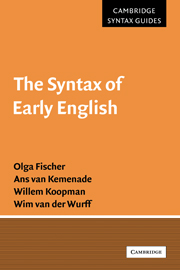Book contents
- Frontmatter
- Contents
- Preface
- List of editions used
- 1 Language change and grammar change
- 2 An outline of Old English syntax
- 3 An outline of Middle English syntax
- 4 The Verb-Second constraint and its loss
- 5 The loss of object–verb word order
- 6 Verb–particles in Old and Middle English
- 7 Changes in infinitival constructions
- 8 The history of the ‘easy-to-please’ construction
- 9 Grammaticalization and grammar change
- References
- Index
4 - The Verb-Second constraint and its loss
Published online by Cambridge University Press: 23 December 2009
- Frontmatter
- Contents
- Preface
- List of editions used
- 1 Language change and grammar change
- 2 An outline of Old English syntax
- 3 An outline of Middle English syntax
- 4 The Verb-Second constraint and its loss
- 5 The loss of object–verb word order
- 6 Verb–particles in Old and Middle English
- 7 Changes in infinitival constructions
- 8 The history of the ‘easy-to-please’ construction
- 9 Grammaticalization and grammar change
- References
- Index
Summary
Introduction
A comparison of the position of the finite verb in Modern English with its precursors in Old English shows up some striking contrasts. As is well known, Modern English has regular SVO word orders in declarative clauses, regardless of whether the verb is finite or not. In questions and negative-initial clauses, we see the phenomenon of ‘subject–aux inversion’:
(1) a. Who did you talk to at the party yesterday?
b. Never have I talked to such a strange character.
Subject–aux inversion – as the name says – is restricted to auxiliaries. Main verbs do not invert in questions, even when they are finite. Rather, a ‘dummy’ auxiliary do is employed as a finite verb when the first verb in a sentence is not an auxiliary. Old English is different in most of these respects, although some of the patterns look rather familiar.
As we saw in chapter 2, Old English had many SVO word orders like those in Modern English, but at least as many SOV word orders, or orders that seem to be a mix of SOV and SVO. The position of the finite verb plays a special role in this: especially in main clauses, it is very often found following one initial constituent, regardless of whether that first constituent is the subject or not, and regardless of the rest of the word order of the clause.
Information
- Type
- Chapter
- Information
- The Syntax of Early English , pp. 104 - 137Publisher: Cambridge University PressPrint publication year: 2001
